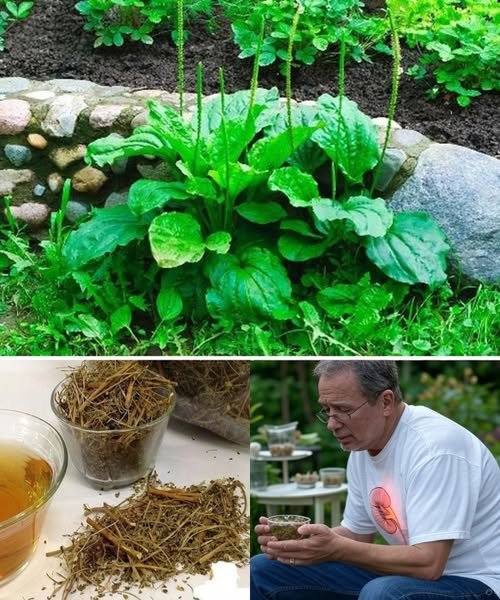Wild Medicinal Plants: Harnessing the Hidden Virtues of Earth’s Greenery
In the wilderness of our environment—ranging from the expanse of meadows to the depths of forests, and even the corners of our gardens—lies a verdant dispensary.
These unassuming plants are a powerhouse of medicinal properties.
Among these are everyday plants like dandelions, nettles, and raspberry leaves, but one lesser-known yet remarkable plant stands out: plantain.
This humble herb is not to be confused with the banana-like fruit; it’s a common weed that’s easily overlooked despite its powerful properties.
The two primary species, Plantago lanceolata (narrow-leaved plantain) and Plantago major (broadleaf plantain), are rich in healthful attributes that modern wellness has largely forgotten.
Are you ready to harness the benefits of these plants?
Foster an interest in herbal lore, seek out a pristine area free from pollutants, and set out on a quest for these green treasures.
Harvesting Plantain: Your How-To
When you spot plantain with its distinctive leaves, and you’re sure of the plant’s purity, begin harvesting. Gently remove the leaves from their base.
You can do this barehanded or with the aid of scissors.
For immediate use, proceed with your recipe. To store them, wash if needed and then dry in bunches hanging in the air or in a dehydrator.
The Healing Virtues of Plantain
For ages, plantain has been a cherished remedy for soothing sore throats and persistent coughs. It’s also known for boosting the immune system, a boon especially in the colder months.
To make a tincture, there’s a basic method to follow: macerate the herb in alcohol, keep it in a dark place, and strain it when it’s ready to use.
Here’s how to go about it:
1. Gathering Quality Ingredients
Begin by selecting fresh plantain, opting for either broadleaf or narrow-leaved varieties. The best pick is what grows in your region. While each kind has its own merits, mixing them can enhance their efficacy.
2. Preparing Your Plantain
Method: Tear the plantain leaves by hand or grind them using a mortar and pestle. Then, place the crushed leaves into a sterilized jar.
3. Mixing with Alcohol
Choose a high-proof vodka or brandy for this infusion, aiming for a 2:1 ratio of alcohol to plantain. Precise measurements aren’t crucial; intuition works well, as the herb’s potency can fluctuate with the seasons and growing conditions.
4. The Waiting Game
Store the tightly sealed jar in a cool, dark place for about a month to six weeks.
Utilizing Plantain: Dosage and Precautions
For an average adult, a common dose is about 1 ml, which can be taken up to three times a day.
LABELING IS CRUCIAL. It’s essential to differentiate between tinctures, as many look similar but possess vastly different properties and applications.
For instance, in our collection of herbal remedies, we have a shepherd’s purse tincture, valued for its hemostatic and hemorrhoidal pain-relieving qualities. Additionally, we store yarrow tincture, known for its circulatory benefits and assistance with varicose veins.
Safety is paramount: Properly labeled bottles are crucial to avoid any mix-ups that could lead to adverse health effects.
Exploring Plantain’s Herbal Possibilities
Rather than uprooting plantains from your lawn, consider harvesting this versatile plant for a host of natural health solutions.
Embarking on a foraging journey can empower you with self-sufficiency as you learn to identify and utilize wild plants, transforming them into valuable remedies such as salves, tinctures, infused oils, and poultices.
Harnessing the Healing Power of Plantain Poultices Best Season to Use:
Summer is prime time for plantain poultices, especially when combatting the irritation of insect bites and stings.
Application Method:
To soothe a bite or sting, choose a fresh plantain leaf, wash it, then chew it until it’s pulpy. Apply this poultice to the affected area and secure it with a bandage. Reapply as necessary to alleviate discomfort.
Taste and Benefits:
Plantain has a slightly bitter flavor but is generally palatable, and it’s well-regarded for its healing properties. It’s especially useful for treating minor cuts.
Cold Season Solutions:
During the cooler months, plantain-based salve is a vital component of any herbal medicine kit.
Plantain-Infused Oil: More Than Just Poultices
Expanding Uses: Infusing plantain in carrier oils like coconut, almond, or olive oil can enhance its healing properties.
Benefits:
The resulting infused oil can be applied to a variety of skin issues, from light burns to irritations.
Connecting with Nature’s Bounty:
Delving into herbal preparations not only promotes a sustainable lifestyle but also unveils the hidden utilities of common plants. Take comfrey, for example—it’s not only a potent medicinal herb but also serves as an effective organic fertilizer.
Preparation Steps:
Harvest fresh plantain leaves under the full sun. Chop or tear the leaves. Let them air-dry on a clean surface overnight. Place the dried leaves in a clear jar. Cover them with your chosen oil, such as high-quality olive oil.
Storage and Finalization:
Keep the jar in a cool, dark place for about a month and a half. After straining the oil, it’s ready for incorporation into balms or direct application on the skin.
Plantain-Infused Vinegar: The Versatile Natural Solution
A Spectrum of Uses: Vinegar infused with plantain is a multipurpose marvel, useful in the kitchen, as a cleaning agent, for personal care, and for its healing properties.
Soothing Sunburn Remedy: For those painful sunburns, consider a natural approach by steeping either fresh or dried plantain leaves in apple cider vinegar for a homemade sunburn relief.
Additional Uses: This same mixture can double as a calming hair rinse for dry, itchy scalps.
Plantain & Lavender Cream: A Herbal Skin Soother Benefits:
Known for its skin-soothing properties, plantain is particularly effective against eczema.
Preparation Steps:
Step 1: Harvest plantain at its peak and dry it for later use.
Step 2: Create a plantain oil infusion and let it steep for several weeks.
Step 3: Use this infused oil to make a cream for treating various skin conditions.
Plantain Lip Care: Tailored Lip Balm Creation The Journey:
For those seeking an alternative to generic lip balms, consider concocting your own unique mixture.
Essential Elements:
Botanicals: Dried calendula, comfrey, and plantain Base Ingredients: Beeswax, raw shea and cocoa butter, and natural castor oil.
The Benefit of DIY:
Making your lip care ensures control over the ingredients, providing a natural and effective product. Plus, having these supplies on hand opens the door to a range of homemade cosmetics and herbal remedies.
Plantain Bath Teas: The Supreme Soak The Attraction:
Nothing beats a calming bath after a strenuous day or tending to household chores.
Ingredients: Favorite essential oils Freshly cut or dried plantain leaves Lavender flowers for added relaxation. Instructions:
Use a muslin bag to contain all ingredients for an indulgent, no-fuss bath without any drain-blocking residue.
Plantain Hydration Sticks: Combat Dry Skin The Challenge:
Persistent dry skin can be tough to manage. Craft a custom moisturizing stick.
Necessary Components: Pure shea butter Coconut oil base Pure beeswax For an added moisture boost, infuse with plantain oil.
Plantain Healing Salve: The Botanical First-Aid Essential Key Benefits:
A plantain salve is a must-have for any natural first-aid kit, offering relief for a variety of skin issues.
Ingredients:
Either fresh or dried plantain leaves Virgin coconut oil Pure beeswax Add essential oils like tea tree or lavender for their antiseptic properties.
Patience is required to prepare this salve, but the healing result is well worth the effort.
Culinary Uses of Plantain: The Unappreciated Delicacy
In the Kitchen: Use young, soft plantain leaves in salads. Toast the seeds for a nutty crunch. Brew the leaves into a soothing tea for dry coughs in the winter.
Finding Plantain:
Though commonly found, plantain may play hide-and-seek when actively sought. Collect it during sunny periods to ensure a supply for your wintertime herbal preparations, such as salves and lip treatments



